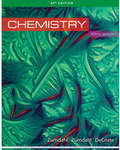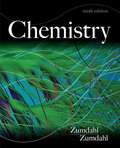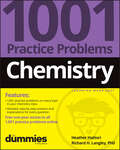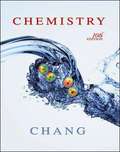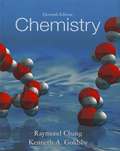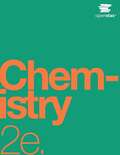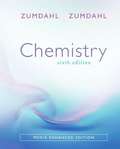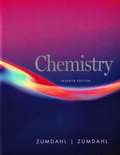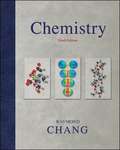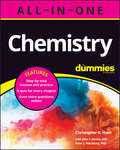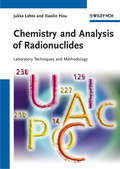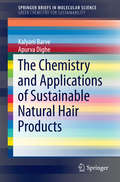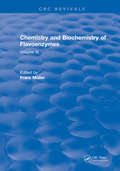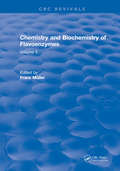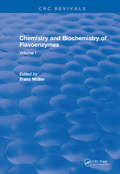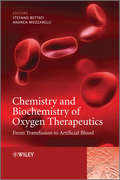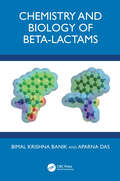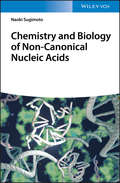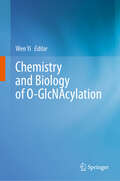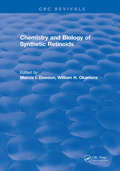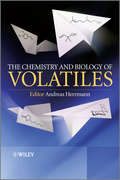- Table View
- List View
Chemistry
by Steven S. Zumdahl Susan A. Zumdahl Donald J. DeCosteLearn the skills you need to succeed in your chemistry course with CHEMISTRY, Tenth Edition. This trusted text has helped generations of students learn to “think like chemists” and develop problem-solving skills needed to master even the most challenging problems. Clear explanations and interactive examples help you build confidence for the exams, so that you can study to understand rather than simply memorize.
Chemistry
by Steven Zumdahl Susan ZumdahlNever HIGHLIGHT a Book Again! Virtually all of the testable terms, concepts, persons, places, and events from the textbook are included. Cram101 Just the FACTS101 studyguides give all of the outlines, highlights, notes, and quizzes for your textbook with optional online comprehensive practice tests. Only Cram101 is Textbook Specific. Accompanys: 9781133611097 .
Chemistry 0120 Lab Manual
by University of Pittsburgh The Department of ChemistryA chemistry textbook
Chemistry: 1001 Practice Problems For Dummies (+ Free Online Practice)
by Heather Hattori Richard H. LangleyPractice your way to a better grade in your Chemistry class Chemistry: 1001 Practice Problems For Dummies gives you 1,001 opportunities to practice solving problems on all the topics covered in your chemistry class—in the book and online! Get extra practice with tricky subjects, solidify what you’ve already learned, and get in-depth walk-throughs for every problem with this useful book. These practice problems and detailed answer explanations will catalyze the reactions in your brain, no matter what your skill level. Thanks to Dummies, you have a resource to help you put key concepts into practice. Work through multiple-choice practice problems on all Chemistry topics covered in class Step through detailed solutions to build your understanding Access practice questions online to study anywhere, any time Improve your grade and up your study game with practice, practice, practiceThe material presented in Chemistry: 1001 Practice Problems For Dummies is an excellent resource for students, as well as parents and tutors looking to help supplement classroom instruction. Chemistry: 1001 Practice Problems For Dummies (9781119883531) was previously published as 1,001 Chemistry Practice Problems For Dummies (9781118549322). While this version features a new Dummies cover and design, the content is the same as the prior release and should not be considered a new or updated product.
Chemistry (10th Edition)
by Raymond ChangChang's best-selling textbook continues to take a traditional approach and is often considered a student and teacher favorite. The book features a straightforward, clear writing style and proven problem-solving strategies. It continues the tradition of providing a firm foundation in chemical concepts and principles while presenting a broad range of topics in a clear, concise manner. The new edition of Chemistry continues to strike a balance between theory and application by incorporating real examples and helping students visualize the three-dimensional atomic and molecular structures that are the basis of chemical activity. An integral part of the text is to develop students? problem-solving and critical thinking skills. A hallmark of the 10th edition is the integration of many tools designed to inspire both. students and teachers. The textbook is a foundation for the unparalleled, effective technology that is integrated throughout. The multimedia package for the new edition. stretches students beyond the confines of the traditional textbook. .
Chemistry (11th Edition)
by Raymond Chang Kenneth A. GoldsbyDesigned for the two-semester general chemistry course, Chang's best-selling textbook continues to take a traditional approach and is often considered a student and teacher favorite. The book features a straightforward, clear writing style and proven problem-solving strategies. It continues the tradition of providing a firm foundation in chemical concepts and principles while presenting a broad range of topics in a clear, concise manner. The tradition of Chemistry has a new addition with co-author, Kenneth Goldsby from Florida State University, adding variations to the 11th edition. The organization of the chapter order has changed with nuclear chemistry moving up in the chapter order. There is a new problem type—Interpreting, Modeling, and Estimating—fully demonstrating what a real life chemist does on a daily basis. The authors have added over 340 new problems to the book. The new edition of Chemistry continues to strike a balance between theory and application by incorporating real examples and helping students visualize the three-dimensional atomic and molecular structures that are the basis of chemical activity. An integral part of the text is to develop students' problem-solving and critical thinking skills
Chemistry 2e
by Paul Flowers Klaus Theopold Richard Langley Edward J. Neth WIlliam R. RobinsonThis is the official print version of this OpenStax textbook. OpenStax makes full-color hardcover and B&W paperback print copies available for students who prefer a hardcopy textbook to go with the free digital version of this OpenStax title. The textbook content is exactly the same as the OpenStax digital book. This textbook is available for free download at the OpenStax dot org website, but as many students prefer to study with hardcopy books, we offer affordable OpenStax textbooks for sale through Amazon as well as most campus bookstores.
Chemistry (5th edition)
by Steven S. Zumdahl Susan A. ZumdahlThe fifth edition of Chemistry presents the concepts of chemistry in a clear, interesting, and student-friendly manner. Since visual material is especially important for learning general chemistry, which typically presents a pictorial view of chemical concepts, the illustrations representing the microscopic world of chemistry have been redone in this edition to improve their clarity and appearance. Special illustrations and color photographs integrate descriptive chemistry with chemical principles, and many new Chemical Impact features emphasize practical applications of newly learned concepts.
Chemistry (6th Edition, Media Enhanced Edition)
by Steven S. Zumdahl Susan A. ZumdahlConceptual approach to problem-solving, high-quality end-of-chapter problems, student friendly writing style and a strong emphasis on models and real-world applications are the highlights of this Chemistry 6th Edition. The new Media Enhanced Edition provides students with easy access to the media resources that support the goals of the text.
Chemistry (7th edition)
by Steven S. Zumdahl Susan A. ZumdahlAuthors bring a conceptual approach to chemistry and integrate problem-solving skills throughout, helping students transition from theory to practice. A strong emphasis on models, real-world applications, and visual learning prevails throughout the text.
Chemistry (9th Edition)
by Raymond ChangThis textbook takes a traditional approach and is designed for the two-semester general chemistry course featuring a straightforward, clear writing style and proven problem-solving strategies. The strength of this edition is the integration of many tools that are designed to inspire both students and instructors.
Chemistry All-in-One For Dummies (+ Chapter Quizzes Online)
by Christopher R. Hren John T. Moore Peter J. MikuleckyEverything you need to crush chemistry with confidence Chemistry All-in-One For Dummies arms you with all the no-nonsense, how-to content you&’ll need to pass your chemistry class with flying colors. You&’ll find tons of practical examples and practice problems, and you&’ll get access to an online quiz for every chapter. Reinforce the concepts you learn in the classroom and beef up your understanding of all the chemistry topics covered in the standard curriculum. Prepping for the AP Chemistry exam? Dummies has your back, with plenty of review before test day. With clear definitions, concise explanations, and plenty of helpful information on everything from matter and molecules to moles and measurements, Chemistry All-in-One For Dummies is a one-stop resource for chem students of all valences. Review all the topics covered in a full-year high school chemistry course or one semester of college chemistry Understand atoms, molecules, and the periodic table of elements Master chemical equations, solutions, and states of matter Complete practice problems and end-of-chapter quizzes (online!)Chemistry All-In-One For Dummies is perfect for students who need help with coursework or want to cram extra hard to ace that chem test.
Chemistry and Analysis of Radionuclides: Laboratory Techniques and Methodology
by Jukka Lehto Xiaolin HouWritten by chemists for chemists, this is a comprehensive guide to the important radionuclides as well as techniques for their separation and analysis. It introduces readers to the important laboratory techniques and methodologies in the field, providing practical instructions on how to handle nuclear waste and radioactivity in the environment.
The Chemistry and Applications of Sustainable Natural Hair Products
by Kalyani Barve Apurva DigheThis book investigates the relationship between phytoconstituentsand properties in specific plants, such as Hibiscus rosa sinesis, Cuscutareflexa, Citrullus colocynthis, Nardostachys jatamansi and Ocimumgratissimum, that are used in hair care products including shampoos,conditioners, dyes, and oils. It explains the impact of these materials on thegrowth, structure, appearance, and health of hair. It also explores how thechemistry of certain plants from sustainable sources is exploited for use inhair products and nutraceuticals. Additionally, the authors include informationon ingredients used for formulating 'green' hair products that treat commonconditions such as canities, dandruff and alopecia.
Chemistry and Biochemistry of Flavoenzymes: Volume III
by Franz MullerChemistry and Biochemistry of Flavoenzymes summarizes the present knowledge of the chemical and physical properties of free flavin, modified flavins occurring in nature, and deazaflavin. This information forms the fundamental basis for understanding the catalytic properties of flavoenzymes. Flavoproteins involved in transport, electron transfer, oxidation, dehydrogenation and hydroxylation reactions are discussed with respect to their biochemical and biophysical properties. The book presents the catalytic mechanisms of the flavoproteins in detail and, where available, three-dimensional structures and molecular biology data are included. The medical aspects of free and protein-bound flavin are also briefly discussed. Chemistry and Biochemistry of Flavoenzymes is an essential reference source for chemists, biochemists, toxicologists, biologists, pharmacologists, and researchers in the pharmaceutical industry.
Chemistry and Biochemistry of Flavoenzymes: Volume II
by Franz MullerChemistry and Biochemistry of Flavoenzymes summarizes the present knowledge of the chemical and physical properties of free flavin, modified flavins occurring in nature, and deazaflavin. This information forms the fundamental basis for understanding the catalytic properties of flavoenzymes. Flavoproteins involved in transport, electron transfer, oxidation, dehydrogenation and hydroxylation reactions are discussed with respect to their biochemical and biophysical properties. The book presents the catalytic mechanisms of the flavoproteins in detail and, where available, three-dimensional structures and molecular biology data are included. The medical aspects of free and protein-bound flavin are also briefly discussed. Chemistry and Biochemistry of Flavoenzymes is an essential reference source for chemists, biochemists, toxicologists, biologists, pharmacologists, and researchers in the pharmaceutical industry.
Chemistry and Biochemistry of Flavoenzymes: Volume I
by Franz MullerChemistry and Biochemistry of Flavoenzymes summarizes the present knowledge of the chemical and physical properties of free flavin, modified flavins occurring in nature, and deazaflavin. This information forms the fundamental basis for understanding the catalytic properties of flavoenzymes. Flavoproteins involved in transport, electron transfer, oxidation, dehydrogenation and hydroxylation reactions are discussed with respect to their biochemical and biophysical properties. The book presents the catalytic mechanisms of the flavoproteins in detail and, where available, three-dimensional structures and molecular biology data are included. The medical aspects of free and protein-bound flavin are also briefly discussed. Chemistry and Biochemistry of Flavoenzymes is an essential reference source for chemists, biochemists, toxicologists, biologists, pharmacologists, and researchers in the pharmaceutical industry.
Chemistry and Biochemistry of Oxygen Therapeutics
by Stefano Bettati Andrea MozzarelliHuman blood performs many important functions including defence against disease and transport of biomolecules, but perhaps the most important is to carry oxygen - the fundamental biochemical fuel - and other blood gases around the cardiovascular system. Traditional therapies for the impairment of this function, or the rapid replacement of lost blood, have centred around blood transfusions. However scientists are developing chemicals (oxygen therapeutics, or "blood substitutes") which have the same oxygen-carrying capability as blood and can be used as replacements for blood transfusion or to treat diseases where oxygen transport is impaired.Chemistry and Biochemistry of Oxygen Therapeutics: From Transfusion to Artificial Blood links the underlying biochemical principles of the field with chemical and biotechnological innovations and pre-clinical development.The first part of the book deals with the chemistry, biochemistry, physiology and toxicity of oxygen, including chapters on hemoglobin reactivity and regulation; the major cellular and physiological control mechanisms of blood flow and oxygen delivery; hemoglobin and myoglobin; nitric oxide and oxygen; and the role of reactive oxygen and nitrogen species in ischemia/reperfusion Injury.The book then discusses medical needs for oxygen supply, including acute traumatic hemorrhage and anemia; diagnosis and treatment of haemorrhages in "non-surgical" patients; management of perioperative bleeding; oxygenation in the preterm neonate; ischemianormobaric and hyperbaric oxygen therapy for ischemic stroke and other neurological conditions; and transfusion therapy in β thalassemia and sickle cell diseaseFinally "old"and new strategies for oxygen supply are described. These include the political, administrative and logistic issues surrounding transfusion; conscientious objection in patient blood management; causes and consequences of red cell incompatibility; biochemistry of red blood cell storage; proteomic investigations on stored red blood cells; red blood cells from stem cells; the universal red blood cell; allosteric effectors of hemoglobin; hemoglobin-based oxygen carriers; oxygen delivery by natural and artificial oxygen carriers; cross-linked and polymerized hemoglobins as potential blood substitutes; design of novel pegylated hemoglobins as oxygen carrying plasma expanders; hb octamers by introduction of surface cysteines; hemoglobin-vesicles as a cellular type hemoglobin-based oxygen carrier; animal models and oxidative biomarkers to evaluate pre-clinical safety of extracellular hemoglobins; and academia - industry collaboration in blood substitute development.Chemistry and Biochemistry of Oxygen Therapeutics: From Transfusion to Artificial Blood is an essential reference for clinicians, haematologists, medicinal chemists, biochemists, molecular biologists, biotechnologists and blood substitute researchers.
Chemistry and Biological Activities of Ivermectin
by Rashid Ali Shahid Ul-IslamCHEMISTRY AND BIOLOGICAL ACTIVITIES OF IVERMECTIN The book focuses on the biological activities of ivermectin as well as the significant global utility of IVM since it was first used about 35 years ago. Ivermectin (IVM) is a “wonder drug” containing a 16-membered macrocyclic lactone ring system in its structure and derived from the family of avermectins. It was isolated by the fermentation of the soil microorganism Streptomyces avermitilis by Satoshi Omura in 1960 and studied by William C. Campbell in 1981, which allowed for its treatment of onchocerciasis (River Blindness) in Africa. Both scientists subsequently received the 2015 Nobel Prize in Physiology or Medicine. It was approved by the FDA in 1997 for the treatment of Strongyloidiasis and crusted scabies in AIDS patients. After that, IVM has attracted the tremendous attention of the scientific community and has been used for diverse purposes, including as an inhibitor of the causative virus (SARS-CoV-2). The chief purpose of this volume is to focus on the chemistry and biological activities of ivermectin. The chapters have been arranged in a systematic manner, starting from the historical background and synthesis of IVM to the pharmacological and environmental aspects, followed by diverse applications. Although the usage of ivermectin for the treatment of COVID-19 remains under investigation and controversial, one of the chapters is dedicated to its use. The anti-parasitic, anti-malarial, anti-cancer, and anti-inflammatory activities of IVM are discussed in detail. The anthelminthic and insecticidal roles of IVM are briefly described and there are several cases of IVM in dermatology. Audience Researchers, scientists, and postgraduate students working in the fields of organic synthesis, medicinal chemistry, medical science, pharmacy, biotechnology and biomedical sciences.
Chemistry and Biology of Beta-Lactams
by Bimal Krishna Banik Aparna DasDue to their medicinal activity and potential use as synthetic starting materials, studies on beta-lactams have increased significantly. This unique volume takes readers on a tour de force from the concept of antibiosis to the serendipity of antibiotics, evolution of beta‐lactam development, and molecular biology of antibiotic resistance. These areas of research have culminated in a deeper understanding of microbiology, particularly in the area of bacterial cell wall synthesis and recycling. Considerable work has been performed by chemists and biologists to continue updating their findings about beta-lactam synthesis.Features:• Stereoselective synthesis of monocyclic, bicyclic, and polycyclic beta-lactams• Microwave, ultrasound, and solid support-mediated preparation of beta-lactams• Diverse medicinal activities including anticancer activities of beta-lactams and products obtained from them• Nanoparticles, artificial intelligence, and dipole moments in beta-lactam science• Synthesis and mechanism of formation of polyaromatic beta-lactams
Chemistry and Biology of Non-canonical Nucleic Acids
by Naoki SugimotoDiscover the fundamentals and intricacies of a subject at the interface of chemistry and biology with this authoritative resource Chemistry and Biology of Non-canonical Nucleic Acids delivers a comprehensive treatment of the chemistry and biology of non-canonical nucleic acids, including their history, structures, stabilities, properties, and functions. You'll learn about the role of these vital compounds in transcription, translation, regulation, telomeres, helicases, cancers, neurodegenerative diseases, therapeutic applications, nanotechnology, and more. An ideal resource for graduate students, researchers in physical, organic, analytical, and inorganic chemistry will learn about uncommon nucleic acids, become the common non-canonical nucleic acids that fascinate and engage academics and professionals in private industry. Split into 15 chapters covering a wide range of aspects of non-canonical nucleic acids, the book explains why these compounds exist at the forefront of a new research revolution at the intersection of chemistry and biology. Chemistry and Biology of Non-canonical Nucleic Acids also covers a broad range of topics critical to understanding these versatile and omnipresent chemicals, including: * A discussion of the dynamic regulation of biosystems by nucleic acids with non-canonical structures * The role played by nucleic acid structures in neurodegenerative diseases and various cancers * An exploration of the future outlook for the chemistry and biology of non-canonical nucleic acids * An introduction to the history of canonical and non-canonical structures of nucleic acids * An analysis of the physicochemical properties of non-canonical nucleic acids Perfect for biochemists, materials scientists, and bioengineers, Chemistry and Biology of Non-canonical Nucleic Acids will also earn a place in the libraries of medicinal and pharmaceutical chemists who wish to improve their understanding of life processes and the role that non-canonical nucleic acids play in them.
Chemistry and Biology of O-GlcNAcylation
by Wen YiO-linked N-acetylglucosamine (O-GlcNAc) is a prevalent post-translational modification of numerous intracellular proteins. This modification has recently emerged as a key regulator of various important biological processes, including gene transcription, stress response, metabolic homeostasis, and immune regulation. Given the critical role of O-GlcNAc in normal physiology, increasing evidence has now demonstrated that deregulation of O-GlcNAc is closely associated with the development and progression of various diseases, including neurodegeneration, cardiovascular disease, and cancer. This book provides a comprehensive overview of the current progress and understanding of this modification in biology, and likely provides new research directions in the future.
Chemistry and Biology of Synthetic Retinoids
by Marcia I. DawsonThe purpose of this book is to present an overview of advances in both retinal and retinoic acid synthetic chemistry and biology. Chapters are written by research workers who are active in these fields. Emphasis is placed on structure-activity relationships. It includes topics of cell differentiation, maintenance of cell morphology, and vision. This reference contains a special section on assays which were developed to measure retinoid activity. This book is ideal for those interested in the fields of photobiology, organic chemistry, biological chemistry, and nutrition.
The Chemistry and Biology of Volatiles
by Andreas Herrmann"Coming to a conclusion, this wonderful, informative and very interesting book presents an excellent overview of small volatile organic compounds and their role in our life and environment. Really fascinating is the entirety of scientific disciplines which were addressed by this book." -Flavour and Fragrance Journal, 2011"... this book deserves to be a well-used reference in the library of any laboratory specialising in VOC". -Chemistry World, 2011Volatile compounds are molecules with a relatively low molecular weight allowing for an efficient evaporation into the air. They are found in many areas of our everyday-life: they are responsible for the communication between species such as plants, insects or mammals; they serve as flavours or fragrances in many food products or perfumed consumer articles; and they play an important role in atmospheric chemistry.This book takes an interdisciplinary approach to volatile molecules. Review-style introductions to the main topics in volatile chemistry and biology are provided by international experts, building into a broad overview of this fascinating field.Topics covered include:The structural variety of volatile compoundsBiogeneration of volatilesSynthesis of natural and non-natural volatilesAnalysis of volatilesVolatile compounds as semiochemicals in plant-plant or plant-insect interactionsVolatiles in pest controlPheromones and the influence of volatiles on mammalsOlfaction and human perceptionVolatiles as fragrancesThe generation of flavours and food aroma compoundsStabilisation and controlled release of volatilesThe impact of volatiles on the environment and the atmosphere
